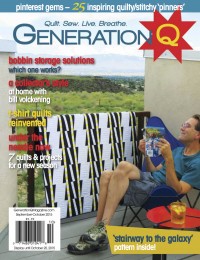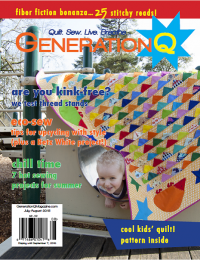(Editor’s Note: There’s been increased fascination in the q-niverse with handwork recently, including hand embroidery, hexagons, and lately, even needleturn applique. Can hand-quilting be far behind? We asked award-winning pro quilter Joe Cunningham to share his thoughts. He’s not not immune to the charms of long-arm quilting, but his truest love may be hand-quilting, which he learned 34 years ago. )
By Joe Cunningham
People seem surprised when they learn that I love to quilt by hand. Maybe that is because I don’t look like a typical hand quilter (whatever that might be). The fact is, however, hand quilting was the first part of the quilting process I learned and it’s the part to which I am most heavily attached. I learned long-arm quilting only out of self defense, because I found myself figuratively standing outside this beautiful long-arm mansion full of people at the long-arm party and I got tired of looking through the window, muttering about how happy I was not to be invited. 
Once I joined the party, I was thrilled to discover that a long-arm machine opened many channels of creative expression. But I also learned that while there were many channels opened by long-arm quilting, there were still just as many for hand quilting. So I do both, and explore each for its unique properties. I don’t have any rules about which quilts I do by hand and which by machine. They just seem to put themselves on one track or the other.
Machine quilting allows me to outrun my brain. That is, the judgmental, mathematical side of my brain is fully occupied while I am working, which gives me the psychic space to improvise and create freely. Hand quilting also occupies the more structured part of my thinking, but free improvisation is difficult because I am going so slowly.
“Slow” is a relative term, however. People have the idea that hand quilting takes thousands of hours. It does not. I can quilt a 72″ x 72″ quilt in 50 to 60 hours. Granted, that is seven or eight times longer than it takes me on a long arm, but it is not a hundred times longer. I simply think very few people have learned high quality hand-quilting techniques, and without that, it can be the most frustrating thing in the world.
For me, there are two parts to the hand-quilting experience that are paramount: the stitch and the frame. The stitch I learned is a simple running stitch executed by driving the needle with a thimble, not holding onto the needle and trying to manipulate it with your fingers. The frame I use is the most basic, old-fashioned frame imaginable–just four narrow boards with strips of fabric attached to them and held together at the corners with “C” clamps. With this frame you quilt all around the outside edge, then roll up the quilted sections on two sides and quilt the next un-quilted part. It is like rolling up a scroll.
The frame has several qualities that, for me, make quilting enjoyable rather than dreadful:
1) With this frame there is no basting. You install the quilt sandwich, then sit down and start quilting.
2) You can simply sit down and start quilting, instead of arranging the basted quilt on your lap, getting the light adjusted and fussing around as you do with a large quilt in a hoop. If you have only a few minutes, you can just grab your thimble and throw in a few stitches.
3) You can see the whole quilt, so you can quilt large designs freehand and always know where you are.
4) When I am working by hand, I reach a mental state of flow that is difficult to achieve when I am working on the machine. Hours seem to melt away.
The last aspect is the most difficult to convey. When people describe hand quilting as “meditative,” it sounds vague to me and like something I may or may not experience. Because I don’t meditate during the rest of my life, it is hard to picture meditating while doing something that requires skillful manipulation of a needle. Here’s how I picture it: Hand quilting occupies the linear, mathematical part of your brain, the part that likes to keep track of things and line them up. While that part is busy, the free-flowing, random, creative part of your brain can take over. The result is you never want to stop. “I’ll just quilt until I reach the corner…okay, around the corner just a little way…one…more…line…” and etc., until the whole day has disappeared. Try it sometime. You’ll see what I mean.
Of course it can be frustrating to have the frame taking up your whole room. That’s why there are different types of frames and quilting hoops, and many ways to quilt. This is just the frame I learned on, and I have never found one I liked better. (If you want to make a frame of your own, it is simple. You can find the plans I used in this article I wrote several years ago: http://www.threadsmagazine.com/item/4286/quilt-it-freehand .)
I was lucky enough be introduced to hand quilting by someone who had studied with expert Mennonite quilters, who were already old-school back in the 1970s. I meet very few quilters today who are familiar with the old-fashioned frame and the rocking stitch. That’s why it is always so thrilling for me to teach this method to a roomful of newbies. I can usually get quilters to a fair level of proficiency in an hour or two, then spend the rest of the day teaching them how to quilt designs.
My next chance to do this will be at my quilt retreat outside Seattle this November. I’ll set up a frame, and spend time each evening with anyone who wants to gather around it and quilt. I love doing this, and not only for the quilting, but also for the simple camaraderie and sense of play that often develops. Go to www.okanarts.com for all the details. (We’ve still got a few spots open for this retreat, which I’m presenting with Patricia Belyea of Okan Arts. Join us!)
Here is the quilt I have in the hand-quilting frame at the moment. Now, I know many people are concerned about the possibility that by starting at the outside and quilting toward the middle, you could end up with a bubble of fullness in the middle. However, the quilt is always held taut in the frame, so fullness never gets a chance to form. Before the 20th century, all quilts were quilted like this, and fullness in the middle was never a problem. And I have been quilting for 34 years, and have never had that problem, either.

The markings on this quilt are taken from a blueprint of a city, so I just marked the most important lines and will quilt the smaller ones freehand.
Here you can see the way I double the main lines and fill in the unmarked single lines:








COMMENT #1
I bought a grace quilting frame and hated it. I’ve tried hoops and they are a pain. So I started with utility quilting to practice. Everything I do is free hand and the quilt is basted but loose in my lap. Its easier for me and the frame is a hassle and takes longer for me. I use a rubber thimble and the rocking stitch. I learned everything from a utility quilting book and lots of online tutorials and articles and of course practicing and making many many mistakes. I think everyone should try hand quilting and find whats easiest for them.
COMMENT #2
I did learn the rocking stitch when I first learned to quilt. We used a quilt-as-you-go frame & I liked the portability of it. The only quilting I’ve done on a big frame was at the L.A. County Fair & I found that much harder for me. Overall though, I’m not much of a hand quilter, as my fingers tend to fall asleep!
COMMENT #3
This was so refreshing to read. I learned at an early age how to quilt from my grandmother and knew the rocking stitch before I knew the name of it! Years later picked up a class Michaels Arts and Crafts when I was working there part time and took an 8 wk quilting class for nothing! It was all hand piecing and hand quilting and I still have that quilt as a reminder of how beautiful handwork can be. I still enjoy it today!
COMMENT #4
I really like hand quilting because you can do it in front of Football (no I wasn’t watching TV for 8 hours, I was quilting!) or while hanging out with your family. I used to do the rocking stitch, but I’ve recently been drawn to using Pearle cotton and quilting with “big” stitches. Since I’ve never had a sewing maching that enabled me to do a lot of FMQ myself, I really enjoy finishing my quilts this way.
COMMENT #5
Great article, Joe! I have used a frame with C-clamps, floor frame my husband made for me, hoop on a stand and hoop on a lap. Which one I choose for quilting on any particular project is determined by my mood at the time, and how much space I have available. Your workshop in Seattle sounds fantastic! I know they will love it.
Celebrate Hand Quilting on Facebook https://www.facebook.com/groups/handquilting/
COMMENT #6
Hi Joe, I love to hand quilt but I can’t understand how you can do the rocking stitch on a taunt fabric. I have quilted on a Hinterberg frame and floor hoop and always kept my quilt very loose in order to rock. I would love to be able to watch you at work. I guess we find our first method to be the easiest. Keep rocking!
COMMENT #7
Hi Joe… how wonderful to see you are still at the frame after all of these years, and you are a fabulous hand quilting artist – is it possible it was 30 years ago YOU taught me to quilt in the big room at Beaver IS. and that the rocking motion has stayed with me for this long. I so absolutely agree about the meditating… great to just be lost in the quilt journey. Your new quilt is wonderful. The quilting will be too…
Beth in Kingston ON Canada now..
COMMENT #8
I think your quilt is fascinating…I would love to see it finished…I hope you show it!